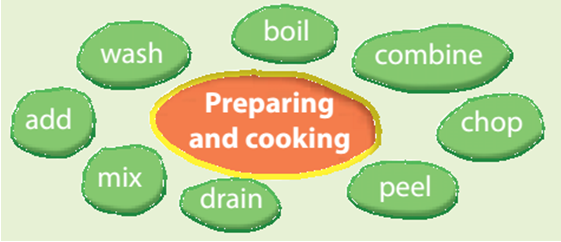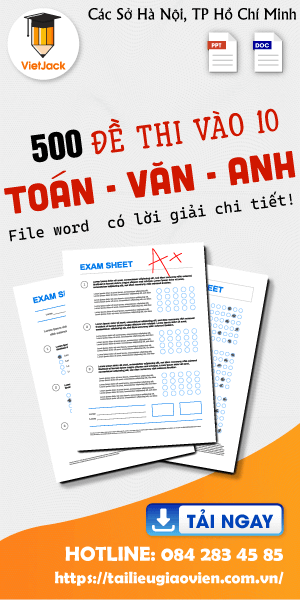Giáo án Tiếng Anh lớp 9 mới Học kì 2 chuẩn nhất
Với mục đích giúp các Thầy / Cô giảng dạy môn Tiếng Anh dễ dàng biên soạn Giáo án Tiếng Anh lớp 9, VietJack biên soạn Bộ kenkenpham phương pháp mới theo hướng phát triển năng lực bám sát mẫu Giáo án môn Tiếng Anh chuẩn của Bộ Giáo dục. Hi vọng tài liệu Giáo án Tiếng Anh 9 này sẽ được Thầy/Cô đón nhận và đóng góp những ý kiến quí báu.
Giáo án Tiếng Anh lớp 9 mới Học kì 2 chuẩn nhất
Chỉ từ 250k mua trọn bộ Kế hoạch bài dạy (KHBD) hay Giáo án Tiếng Anh 9 thí điểm (cả năm) bản word có lời giải chi tiết:
- B1: gửi phí vào tk:
1133836868- CT TNHH DAU TU VA DV GD VIETJACK - Ngân hàng MB (QR) - B2: Nhắn tin tới Zalo VietJack Official - nhấn vào đây để thông báo và nhận giáo án
- Giáo án Tiếng Anh 9 Unit 7: Recipes and eating habbits
- Giáo án Tiếng Anh 9 Unit 8: Tourism
- Giáo án Tiếng Anh 9 Unit 9: English in the world
- Giáo án Tiếng Anh 9 Review 3
- Giáo án Tiếng Anh 9 Unit 10: Space travel
- Giáo án Tiếng Anh 9 Unit 11: Changing roles in society
- Giáo án Tiếng Anh 9 Unit 12: My future career
- Giáo án Tiếng Anh 9 Review 4
Giáo án Tiếng Anh 9 Unit 7: Recipes and eating habbits
Lesson 1 - GETTING STARTED
I. OBJECTIVES: By the end of this Unit, students will be able to:
• Use some vocabularies and structures to talk about their favourite dishes and recipes for dishes
II . PREPARATION: sub -board, pictures, cassette
III. PROCEDURES:
| Teacher’s and students’ activities | Content |
|---|---|
| Activity 1:
-Ask Ss to open their books and look at the picture and the phrase under GETTING STARTED. Ask them some questions: Who can you see in the picture? What is there on the table? Where are the people? What do you think the people in the picture are talking about? |
|
| a/ Have Ss work independently to ¬find the words with the given meanings in the dialogue. Allow Ss to share
their answers before asking them to discuss as a class. Remember to ask Ss to read out the lines in the
dialogue that contain the words. Quickly write the correct answers on the board.
- Have Ss look at the Watch out! box and quickly read the information. If time allows, ask Ss to make some examples with the expressions. |
1. starter 2. versatile 3. drain 4. peel 5. chop 6. combine |
| b/ Ask Ss to work in pairs and complete the word webs. Call on one pair to write their answers on the board. Other pairs add more words if needed.
|
1. Nick’s mum.
2. Because it’s simple and delicious. 3. In the summertime. 4. They are versatile, and you can use lots of different ingredients in a salad. 5. Nick’s mum boils and drains the prawns. Nick washes the celery, peels the prawns, and mixes the ingredients. Mi washes the spring onions, chops the celery and spring onions, and mixes the ingredients. 6. Because he is finding it difficult to wait for one hour. |
| c/ Have Ss read the questions to make sure they understand them. Ask them ¬ firstly to answer the questions without reading the dialogue again. Have Ss exchange their answers with a classmate. Now ask them to check their answers by reading the dialogue again. Ask for Ss’ answers. | |
| Activity 2:
- Have Ss look at the pictures. Tell Ss that in the box are some dishes from different countries in the world. - Ask Ss to write these dishes under the pictures, and then compare their answers in pairs. Play the audio for Ss to check and repeat the answers. |
A. Cobb salad B. sushi C. steak pie D. fajitas E. lasagne F. mango sticky rice G. beef noodle soup H. curry |
| Activity 3:
a/ Have Ss work in pairs to discuss what country in the box is associated with each dish in 2. Check and confirm the correct answers. |
A. The USA B. Japan C. The UK D. Mexico E. Italy F. Thailand G. Viet Nam H. India |
| b/ Tell Ss to complete the sentences with the names of the dishes in2. The complete sentences will give Ss information about these dishes. Call on two Ss to write their answers on the board.
- If time allows, T may organise a short activity to check Ss’ short-term memory. Have Ss close their books. Point at each of Ss’ answers on the board and quickly Ss have to call out the country where the dish comes from. |
1. Lasagne 2. curry 3. steak pie 4. Fajitas 5. sushi |
| Activity 4:
- Ask Ss to work in groups to do the quiz. The group which has the answers the fastest is invited to read out their answers. Elicit feedback from other groups and ask them to add some other answers. - If there is some time left, have Ss work in their groups and write down a similar quiz. Set a time limit of about five minutes. When time is up, ask the ¬ first group to read out a question in their quiz. Ss from other groups give the answers. Other Ss decide if their answers are correct. Continue the activity until all the groups have read out all of their questions or when time is up. |
1. beef 2. prawn, potato 3. cheese, butter, ice cream 4. strawberry, lychee, cherry, pomegranate 5. broccoli, spinach, lettuce, celery, kohlrabi |
IV- HOMEWORK:
-Practice reading the dialogue.
-Write new words then learn them by heart.
-Copy the exercise into notebooks. Prepare A CLOSER LOOK 1
Lesson 2 - A CLOSER LOOK 1
I. OBJECTIVES: By the end of this Unit, students will be able to:
• use the lexical items related to dishes and ways of preparing and cooking food
• ask statement questions with the correct intonation
II . PREPARATION: sub -board, pictures, cassette
III. PROCEDURES:
| Teacher’s and students’ activities | Content |
|---|---|
| Activity 1:
Have Ss work individually to do this exercise and then compare their answers with a classmate. Elicit the answers from Ss and quickly write them on the board. Do not confirm the correct answers at this stage. Have Ss explain the meaning of each verb in English or Vietnamese. Correct Ss’ explanations when needed. –whisk: beat eggs, cream, etc., with a special tool to add air and make the food light (đánh trứng, kem…) –slice: cut something into thin at pieces (thái lát) –grate: rub food (e.g. cheese) against a grater in order to cut it into very small pieces (nạo) – dip: put something quickly into a drink, sauce or batter and take it out again (nhúng) –chop: cut something into pieces with a knife (chặt, cắt) –spread: put a layer of a substance evenly onto the surface of something (phết) –sprinkle: shake small pieces of something, or drops of a liquid, on something (rắc) –marinate: pour a mixture, usually containing oil, wine or vinegar, and herbs and spices, over meat or fish before it is cooked to add favour or make it tender (ướp) Now have Ss look at their answers on the board and say if these are correct. |
A. chop B. slice C. grate D. marinate E. whisk F. dip G. sprinkle H. spread |
| Activity 2:
The purpose of this exercise is to help Ss use the verbs correctly to talk about food preparation. Ask Ss to work in pairs to do the exercise. Check the answers as a class. If time allows, have Ss make sentences. |
1. chop; Slice 2. grates; sprinkles 3. Marinate 4. whisk 5. Dip 6. spread |
| Activity 3:
Have Ss do this exercise individually and then compare their answers with a partner. Check and con-firm the correct answers. Have Ss give the Vietnamese translation of the words if needed. |
1. g 2. f 3. h 4. c 5. e 6. a 7. d 8. b |
| Activity 4:
a/ Ask Ss to answer the two questions. Elicit their answers. Ask them if they have ever eaten or made a pizza. If Ss have eaten pizza, ask them if they like the dish. If they have made a pizza themselves, ask them to describe the process of making one briefly. |
tomato sauce, onion, cheese, apple, bacon, pizza base → pizza |
| b/ Have Ss complete the instructions individually and then compare their answers with a partner. Check the answers as a class. Ask Ss who have not made a pizza before if they can make a pizza themselves after reading the instructions | 1. Chop 2. Grate 3. Spread 4. Sprinkle 5. Spread 6. Bake |
| Activity 5:
Ask Ss to read through the three conversations. Play the recording for Ss to draw appropriate arrows to indicate the intonation of each sentence. Have Ss compare their answers in pairs. Call on some pairs to read the conversations out loud. Correct any mistakes. For a more able class, have Ss work in pairs and draw the arrows first. Then play the recording for them to check their answers. |
|
| Activity 6:
a/ Ask Ss to work in pairs to complete the mini-dialogues with suitable statement questions. Call on some pairs to write their answers on the board. Give comments when needed. b/ Have Ss practise the mini-dialogues and act them out in front of the class with the correct intonation. Ask other Ss to comment. If time allows, let Ss write their own mini-dialogues with statement questions. |
Suggested answer:
1. You don’t like pasta?/Don’t like pasta? 2. Add some salt? |
IV- HOMEWORK:
-Write new words then learn them by heart.
-Copy the exercise into notebooks.
-Prepare A CLOSER LOOK 2
Giáo án Tiếng Anh 9 Unit 8: Tourism
Lesson 1 - GETTING STARTED
I. OBJECTIVES: By the end of this Unit, students will be able to: use lexical items related to tourism
II . PREPARATION: sub -board, pictures, cassette
III. PROCEDURES:
| Teacher’s and students’ activities | Content |
|---|---|
| Activity 1:
Let ss open their book to GETTING STARTED Tell them to look at the picture and answer the questions: -What are Nick and Chau talking about? -What place/ city may they be mentioning? -What do you know about thus city country? Tell ss thay are going to listen to Nick and Chau talking about Nick’s plans for his summer holiday. Play the recording and have ss follow along. |
1)Listen and read / p.18 |
| a) Play the recording twice or more
Ss do the exercise individually. Check and write the correct answers on the board. T may call on an able st to write the answers on the board. Explain to ss the meaning and the use of the three expressions in the Watch out box. ASk ss to locate them in the conversation. |
Ex a) Find a word / phrase in the conversation that means:
1. made up your mind 2.narrowed it down 3. a package tour 4.explore 5.not my cup of tea |
| b) Ss work in pairs.
Tell them to refer back to the conversation when necessary. Explain anything difficult. T needs to explain to ss “ snails and frogs’ legs are specialities in France. |
Ex b)Tick true (T) or false (F)
1. F
2.T 3.T 4.F 5.F |
| c) Ss work individually , then compare their answers with a partner.
Help them find the information in the conversation.
Call on some pairs ro read out the questions and give their answers.
Check their answers.
|
Ex c) Answer the following questions.
1.It means Nick’s parents are relaxed and open-minded.
2. It’s quite warm ( warmer than in Britain)
3.Visit the Alps , and climb Mont Blanc, explore Paris , and go sightseeing in the historic city of Versailles.
4. Eat frogs’legs and snails.
5.She says “ lucky you” when Nick says he can make his own decisions.
|
| Activity 2:
This activity aims at giving the collocations of common words related to the topic of travelling and tourism.
Ss work in pairs first. Check their work, then let them read and remember each collocation.
|
Ex 2) Collocation: Whoch word goes with which list below?
1.hoilday
2.resort
3.tour
4.trip
|
| Activity 3:
This exercise is a revision of words / phrases from previous lessons.
Let ss work individually to do the task. Check their answers.
If time allows , call on some ss to read the passage with the correct answers.
|
Ex 3) Fill each blank with a word / phrase from the list.
1. seaside resort
2.souvenir
3.destination
4.in advance
5. delayed
6.luggage
7.accommodation
8.price
|
| Activity 4:
Ss do the exercise individually, then check their answers.
T may encourage each st to make a similar quiz for their partnaer to do. T may pick up any interesting questions and give them to the whole class. Praise good ideas.
Ss work in groups for 4, 5, 6. Check and give comments.
|
Ex 4) Quiz.
1. Da Nang City
2. The Great Wall of China
3. Jeju island
4. ss’ answers
5. ss’ answers
6. ss’ answers
|
V- HOMEWORK:
-Practice reading the dialogue.
-Write new words then learn them by heart.
-Copy the exercise into notebooks.
-Prepare A CLOSER LOOK 1
Lesson 2 - A CLOSER LOOK 1
I. OBJECTIVES: By the end of this Unit, students will be able to:use common compound nouns.
II . PREPARATION: sub -board, pictures, cassette
III. PROCEDURES:
| Teacher’s and students’ activities | Content |
|---|---|
| Activity 1:
Ss work individually, then compare their answers with a partner’s. Ask some ss to write their answers on the board. Check their answers as a class. Have them make sentences with the words if necessary. |
VOCABULARY
Adjectives Ex 1) Match each word / phrase with a definition. 1.tour 2.resort 3.travel 4.tour guide 5.trip 6.expedition |
| Activity 2:
Ss work in pairs. Call on some ss to write the answers on the board.Correct as a class. T may ask some ss to answer some questions about the passage: -What piece of writing is it? ( introduction of a tourist attraction? itinerary? advertisement?) -What is EcoTours? ( A travel Agency / company?) -What is special about EcoTours? ( It gives some money to protect the environment) |
Ex 2) Fill each blank with a word from the list. There are two extra words..
1.travel 2.book 3.visit 4.environment 5.guides 6.holiday 7.reasonable 8.pleased |
| Give examples of the compound nouns ss already know: blackboard, swimming pool, haircut, tablespoon..
Ask them to give some more. Help ss study the Grammar box and the Look out box. Tell them to look up the spelling of words in the dictionary if they are not sure. |
Compound nouns
A compound noun is a noun that is made of two or more words. Compound nouns can be formed using the following combinations. Noun + noun : toothpaste Noun + verb : rainfall Noun + particle : passer-by Verb + Particle : check out Verb-ing + noun : drving licence Adjective + noun : greenhouse Particle + noun : underground Particle + verb : output Note : A particle is a preposition or an adverb Look out A compound nnoun can be written as a single word ( motorbike), a word with a hyphen ( passer-by) , or two words ( driving licence) |
| Activity 3:
Ss work individually. Tell them to look at the words given and think which of them can go with which one in each definition. When they finish, check their answers and write the words on the board. Ask ss to take notice of the spelling : whether the words are written as one word or as two separate words, or with a hyphen. |
Ex 3) Use the words below to complete the compound nouns that match the definitions.
1. jet lag 2.drawback 3.stopover 4.peak season 5.check-in 6.bus stop |
| First write a finding out question and a making sure question on the board.
Read the two questions to ss with the right tone ( several times if necessary) and let them give the rules. Explain the Look Out Box to them. |
PRONUNCIATION
Tones in asking for information. Finding out questions ( ‘ open’ questions) usually end with a falling tone: What part of Australia have you been to? Making sure questions ( ‘ check’ questions) usually end with a falling -raising tone: Have you just come back from South Africa? |
| Activity 5
Play the recording once for ss to listen, then play it again sentence by sentence for them to repeat. Have ss repeat the questions as many times as necessary. Correct their pronunciation and intonation. After that have ss mark the questions with a falling or falling-rising tone. Check as a class. |
Ex 5) Listen and repeat the following mini-talks, paying attentions to the tone in the questions.
1.Where would you like to go sightseeing? 2. What do you think of the newly discovered cave? 3. Have you been sightseeing all day? 4. Is Egypt a famous tourist attraction? |
| Activity 6
Ss work in pairs to read the conversation, and mark the questions with falling or falling-rising arrows. Call on some pairs to read aloud to the class. Do not correct their mistakes yet. Play the recording . Ss listen and check. |
Ex 6) Mark the questions with falling or falling-raising arrows, and practise the conversation with a partner. Then listen to check your pronunciation.
-What’s the matter, Janet? - I’m looking for my passport. It seems to be lost. - Have you already searched your purse? -Not yet. Oh, where are my glasses? -They may be in your plastic bag. Where is it? -Oh, no. It’s not here. Have I dropped it on the plane? -Oh my God. -What should I do now? -Let’s report it to the customs office. |
IV- HOMEWORK:
-Write new words then learn them by heart.
-Copy the exercise into notebooks.
-Prepare A CLOSER LOOK 2
Tủ sách VIETJACK luyện thi vào 10 cho 2k11 (2026):
Đã có app VietJack trên điện thoại, giải bài tập SGK, SBT Soạn văn, Văn mẫu, Thi online, Bài giảng....miễn phí. Tải ngay ứng dụng trên Android và iOS.
Loạt bài Giáo án Sinh học lớp 9 mới, chuẩn nhất của chúng tôi được biên soạn bám sát nội dung sgk Sinh học 9 theo chuẩn Giáo án của Bộ GD & ĐT.
Nếu thấy hay, hãy động viên và chia sẻ nhé! Các bình luận không phù hợp với nội quy bình luận trang web sẽ bị cấm bình luận vĩnh viễn.
- Giáo án lớp 9 (các môn học)
- Giáo án điện tử lớp 9 (các môn học)
- Giáo án Toán 9
- Giáo án Ngữ văn 9
- Giáo án Tiếng Anh 9
- Giáo án Khoa học tự nhiên 9
- Giáo án Vật Lí 9
- Giáo án Hóa học 9
- Giáo án Sinh học 9
- Giáo án Địa Lí 9
- Giáo án Lịch Sử 9
- Giáo án GDCD 9
- Giáo án Tin học 9
- Giáo án Công nghệ 9
- Đề thi lớp 9 (các môn học)
- Đề thi Ngữ Văn 9 (có đáp án)
- Đề thi Toán 9 (có đáp án)
- Đề thi Tiếng Anh 9 mới (có đáp án)
- Đề thi Tiếng Anh 9 (có đáp án)
- Đề thi Khoa học tự nhiên 9 (có đáp án)
- Đề thi Lịch Sử và Địa Lí 9 (có đáp án)
- Đề thi GDCD 9 (có đáp án)
- Đề thi Tin học 9 (có đáp án)
- Đề thi Công nghệ 9 (có đáp án)






 Giải bài tập SGK & SBT
Giải bài tập SGK & SBT
 Tài liệu giáo viên
Tài liệu giáo viên
 Sách
Sách
 Khóa học
Khóa học
 Thi online
Thi online
 Hỏi đáp
Hỏi đáp

